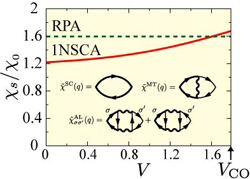Enhanced Spin Susceptibility toward the Charge-Ordering Transition
Kato Group
Charge-ordering (CO) transition in organic conductors has attracted much interest as emergence of strong correlation effect induced by long-range Coulomb interaction. Many CO materials show a sharp metal-insulator transition characterized by a rapid exponential increase of resistivity below the metal-insulator transition temperature TMI. In contrast to remarkable change in the charge degree of freedom, the spin susceptibility is frequently less sensitive to the CO transition, but exhibits non-trivial dependence on temperature. For example, the spin susceptibility of θ-(BEDT-TTF)2RbZn(SCN)4, which is a typical CO material, has a broad peak around TMI without any sign of singularity. In the weak-coupling theory like random phase approximation (RPA), the CO transition is described from the metallic side by divergent development of charge fluctuation at a finite wave number corresponding to charge pattern in the CO phase. Is it possible to understand gradual increase of the spin susceptibility toward the CO transition by development of charge fluctuation? In order to answer this question, RPA is unsuitable because the spin susceptibility in RPA is not affected at all by charge fluctuation. Therefore, we have to go beyond RPA by considering the vertex corrections for describing coupling between charge and spin fluctuations.

Fig.1. Spin susceptibility as a function of the nearest-neighbor Coulomb interaction V for T=0.1 and U=3. Susceptibility is normalized by the Pauli susceptibility of noninteracting electron systems. Three types of diagrams treated in the present calculation are also shown.
We have studied response functions up to leading contribution of vertex corrections in a two-dimensional extended Hubbard model [1, 2]. We have formulated an iterative method for producing a series of the non-skeleton diagrammatic expansions within the framework of Baym-Kadanoff conserving approximation, and have used the first step of this non-skeleton conserving approximation (1NSCA). In Fig. 1, we show the spin susceptibility as a function of the nearest-neighbor Coulomb interaction V. The temperature and the on-site Coulomb interaction are taken as T=0.1 and U=3, respectively. The spin susceptibility is gradually enhanced toward the CO transition point at V=VCO. 1NSCA consists of a sum of three diagrams for the irreducible response function as shown in the figure: The self-energy correction (SC), the Maki-Thompson vertex correction (MT), and the Asmalazov-Larkin (AL) vertex correction. In our calculation, the AL vertex correction is responsible for enhancement of the spin susceptibility.
Our result is consistent with experimental measurement of the spin susceptibility for the organic CO materials, θ-(BEDT-TTF)2RbZn(SCN)4 and β-(meso-DMBEDT-TTF)2PF6. We also speculate that the spin susceptibility of inorganic CO materials such as β-Na0.33V2O5 may be explained by our theory. Detailed comparison between theory and experiment is a future problem. We note that the spin susceptibility is suppressed by antiferromagnetic spin fluctuation [3]. Our study of the spin susceptibility in the CO materials will give a fundamental insight to the interplay of the spin and charge degree of freedom in strongly interacting electron systems.
References
- K. Yoshimi, Ph. D Thesis, University of Tokyo (2009).
- K. Yoshimi, T. Kato, and H. Maebashi, submitted to J. Phys. Soc. Jpn.
- Y. Fuseya, H. Maebashi, S. Yotsuhashi, and K. Miyake, J. Phys. Soc. Jpn. 69, 2158 (2000).
